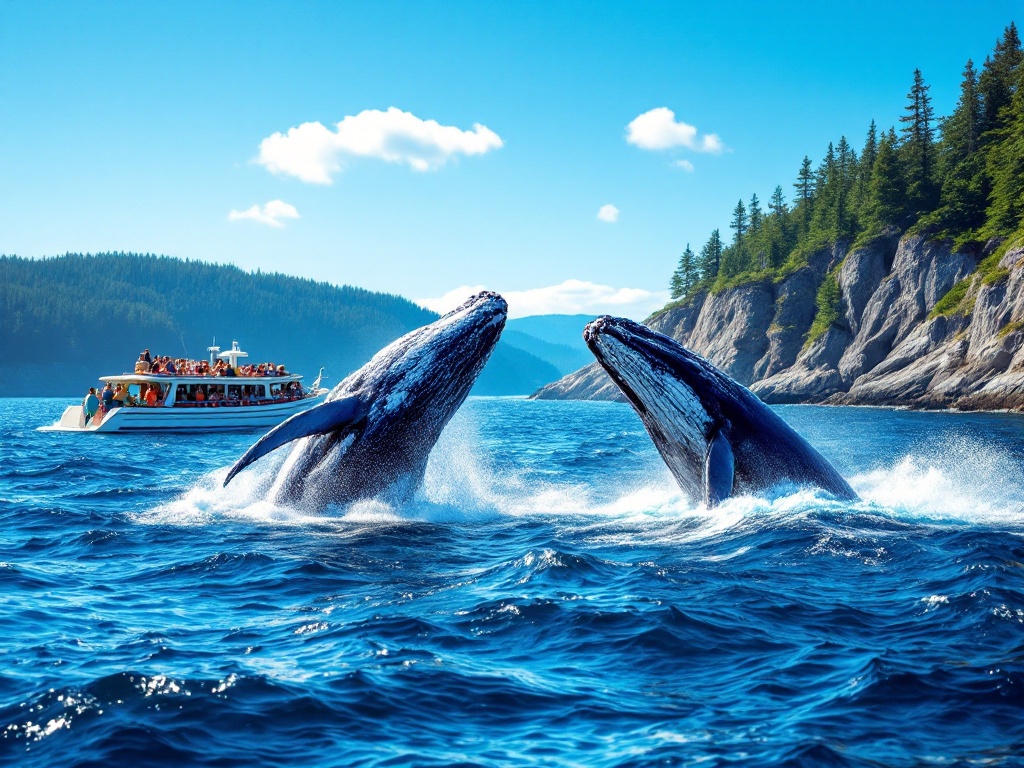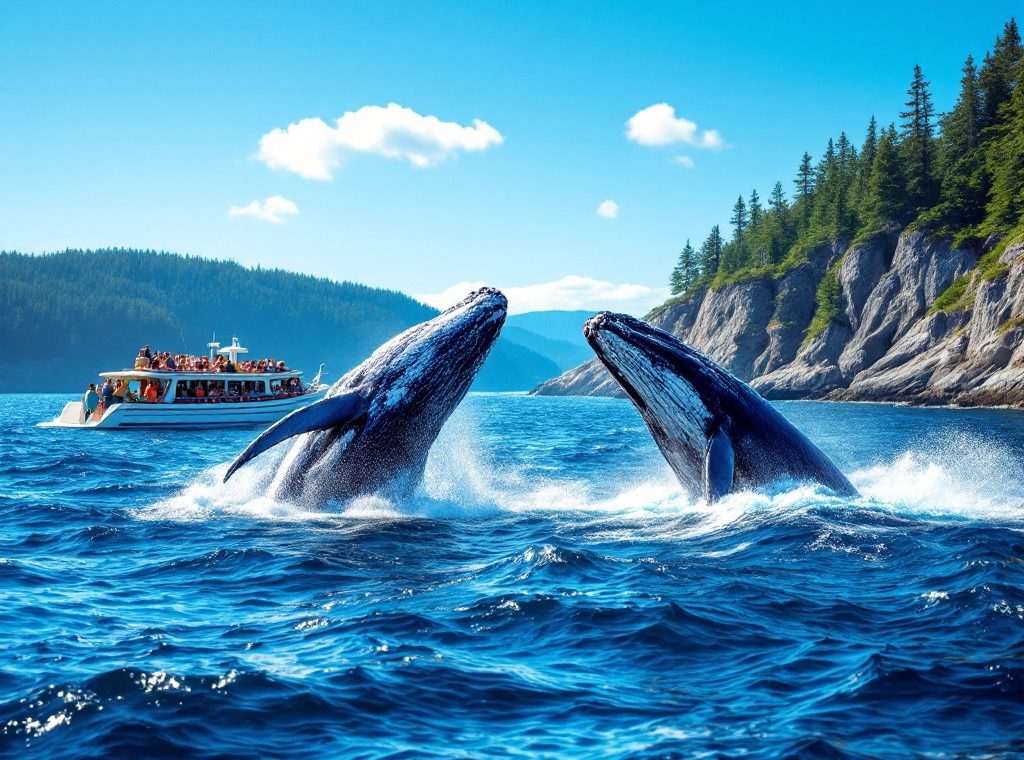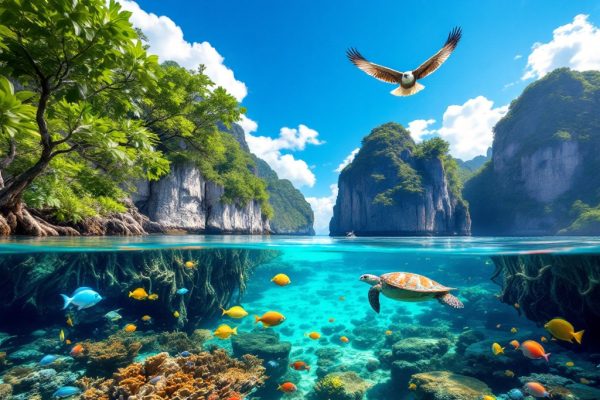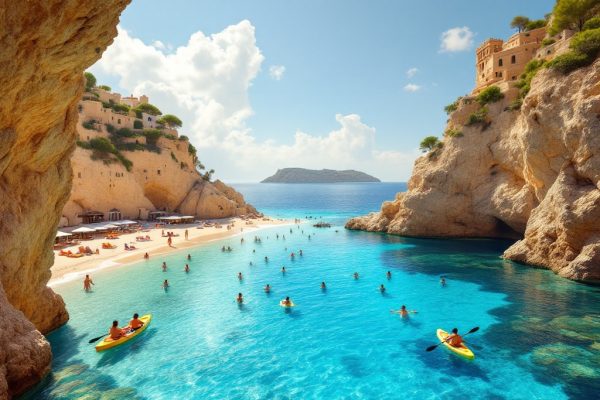Whale Watching in the Bay of Fundy in Canada
Witness the breathtaking spectacle of whales in Canada’s Bay of Fundy! From June to October, this vibrant ecosystem teems with humpbacks, minkes, and even the endangered North Atlantic right whale. Expert-led boat tours offer unforgettable encounters, enriching your understanding of these majestic creatures and their habitat. Dive into an adventure and book your Bay of Fundy whale watching tour today!
Important information

- The Bay of Fundy, known for its high tides and nutrient-rich waters, attracts many whale species, including humpbacks, minkes, and the endangered North Atlantic right whale.
- Peak whale watching season is from June to September, with sightings possible through October.
- Guided boat tours, including Zodiac and eco-tours, offer expert insights into whale behavior and their habitat.
- Brier Island, Grand Manan, Campobello Island, St. Andrews, and Digby are prime whale watching locations.
- Choosing responsible tour operators who prioritize sustainable practices helps protect whales and their environment.
Why the Bay of Fundy is a Top Destination for Whale Watching
The Bay of Fundy, home to the world’s highest tides, nurtures a vibrant ecosystem attracting diverse whale species. Its nutrient-rich waters provide an excellent feeding ground, especially active during the summer months. Visitors can witness humpbacks, minkes, and even the endangered North Atlantic right whale. Combined with dramatic cliffs and breathtaking coastal scenery, whale watching in the Bay of Fundy is an unforgettable experience.
Whale Watching Season: Best Times to Visit
The Bay of Fundy is a prime whale-watching destination from June through October. Peak season lasts from June to September, offering the best viewing conditions thanks to warmer weather and calmer seas. However, October still provides opportunities to spot these magnificent creatures as they migrate to feast on the bay’s plentiful krill and fish.
Optimal Months for Whale Sightings: June to October
The Bay of Fundy offers prime whale-watching opportunities from June through October. During this peak season, whales migrate to the bay, drawn by its abundant marine life. It’s a perfect time to spot various whale species, such as humpback whales, fin whales, minke whales, and the endangered North Atlantic right whale.
Seasonal Patterns of Whale Species in the Bay of Fundy
Each spring, humpback whales migrate to the Bay of Fundy, joining the resident minke whales. The endangered North Atlantic right whale can also be spotted in these waters, along with the frequently sighted fin whale.
Common Whale Species in the Bay of Fundy
The Bay of Fundy is a vibrant ecosystem teeming with life, attracting a variety of whale species. Humpback, minke, and finback whales are frequent visitors, drawn by the abundant food supply. Even the endangered North Atlantic right whale occasionally graces these waters.
Spotting the Endangered North Atlantic Right Whale
Each summer, North Atlantic right whales journey to the Bay of Fundy, a vital observation area for these endangered animals. Humpback and minke whales are also common sights in this critical habitat.
Humpback Whales: Returning in Spring
Each spring, humpback whales journey back to the nutrient-rich waters of the Bay of Fundy, a perfect feeding ground teeming with life.
Minke Whales: Year-Round Residents
Minke whales are year-round residents of the Bay of Fundy, and they play a crucial role in its ecosystem.
Finback Whales and Other Marine Giants
Finback whales, among the ocean’s largest creatures, grace the Bay of Fundy. This vibrant ecosystem also hosts humpback and North Atlantic right whales. Their collective presence attracts tourists globally, eager to witness these magnificent animals.
Top Whale Watching Locations in the Bay of Fundy
Brier Island is renowned for its abundant marine life and is a prime location for whale watching. From Brier Island, you can witness magnificent whales in their natural habitat.
Alternatively, the coastal towns of St. Andrews and Digby serve as popular departure points for numerous whale watching tours.
Grand Manan and Campobello Island also offer excellent whale watching opportunities. From these islands, you can also witness magnificent whales in their natural habitat.
Regardless of whether you embark from an island or a coastal town, the chances of a whale sighting remain high.
Brier Island and Its Surrounding Waters
Brier Island’s waters provide a rich summer feeding ground for diverse marine life, making it an excellent location for whale watching.
Grand Manan and Campobello Island
Grand Manan and Campobello Island offer incredible whale watching opportunities. Their proximity to abundant feeding grounds draws whales, creating a truly spectacular display.
St. Andrews and Digby: Starting Points for Tours
St. Andrews and Digby are popular destinations for whale watching tours. They offer access to the Bay of Fundy, renowned for its diverse marine life, including a variety of whales.
Whale Watching Tours: What to Expect
Experience the thrill of whale watching in the Bay of Fundy. Explore a variety of tours led by expert naturalists and marine guides. For an up-close adventure, choose a thrilling Zodiac tour. If you prefer a responsible viewing perspective, consider an eco-tour. Your safety and enjoyment are our top priorities, with tour operators committed to creating unforgettable whale encounters.
Different Types of Tours: Zodiac and Eco Tours
Experience the thrill of a Zodiac tour, speeding across the waves for up-close whale encounters. For a different kind of adventure, eco-tours minimize environmental impact while offering educational and responsible travel experiences.
Guidance from Naturalists and Marine Tour Operators
Naturalists and marine tour operators offer invaluable expertise on whale behavior, ecology, and conservation, enriching the whale watching experience. They skillfully identify different species, explaining their feeding habits, migration patterns, and complex social structures. With their intimate knowledge of the Bay of Fundy, including its tides, currents, and prime viewing locations, these experts maximize your chances of witnessing these magnificent creatures. Responsible whale watching practices are paramount. Operators emphasize methods that minimize disturbance to the whales and their habitat, ensuring a safe and educational adventure. This commitment to conservation creates a truly memorable and informative experience, making whale watching both thrilling and enlightening.
Safety and Enjoyment: Ensuring a Memorable Experience
Experience the wonders of whale watching in the Bay of Fundy, where safety is the top priority. Tour operators adhere to strict regulations, ensuring a secure and enjoyable experience for all. Knowledgeable captains and crew provide valuable insights into whale behavior, conservation efforts, and the rich local ecosystem. Enjoy a memorable and worry-free adventure, exploring the bay’s magnificent whales in their natural habitat.
Conservation and Sustainable Whale Watching Practices
Sustainable whale watching protects these magnificent creatures and their ocean environment. Choosing responsible tour operators is essential. These operators follow guidelines such as maintaining safe distances, limiting viewing time, and avoiding sudden movements to minimize disturbance. Supporting research and learning about whale behavior and habitat are also crucial for their protection. Here’s how you can contribute to responsible whale watching:
- Choose certified operators committed to sustainable practices.
- Respect safe distances and viewing times to avoid stressing the whales.
- Minimize disturbance by avoiding sudden movements or loud noises.
- Support research initiatives that contribute to whale conservation.
- Educate yourself about whale behavior and habitat to enhance your appreciation and understanding.
By following these practices, we can help ensure the whales’ future.
Contributing to the Protection of Endangered Species
Responsible whale watching tours play a vital role in protecting endangered North Atlantic right whales. These tours educate the public and raise awareness about these magnificent creatures. Tour operators collaborate with research organizations, providing valuable data on whale sightings and behavior. This information helps scientists monitor populations, track migrations, and develop effective conservation strategies. By choosing responsible whale watching, tourists directly support these vital efforts and contribute financially to research and conservation. It’s a beneficial experience for both whales and people.
Benefits of Responsible Whale Watching Tours
- educate the public about North Atlantic right whales,
- raise awareness about these magnificent creatures,
- provide valuable data on whale sightings and behavior to research organizations,
- help scientists monitor populations, track migrations, and develop effective conservation strategies,
- allow tourists to directly support vital conservation efforts.
How Responsible Whale Watching Helps
By choosing responsible whale watching tours, tourists contribute financially to research and conservation efforts. This support helps scientists monitor whale populations, track migrations, and develop effective conservation strategies. It’s a win-win situation for both the whales and the people who admire them.













